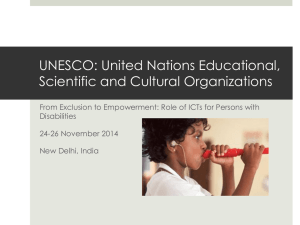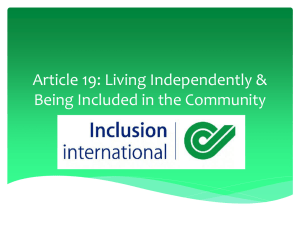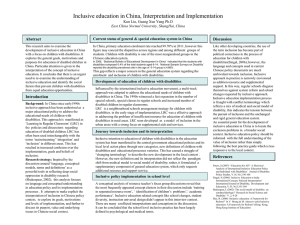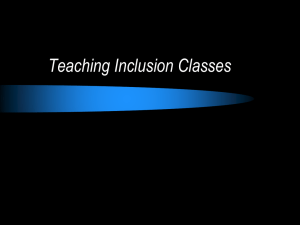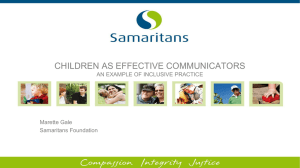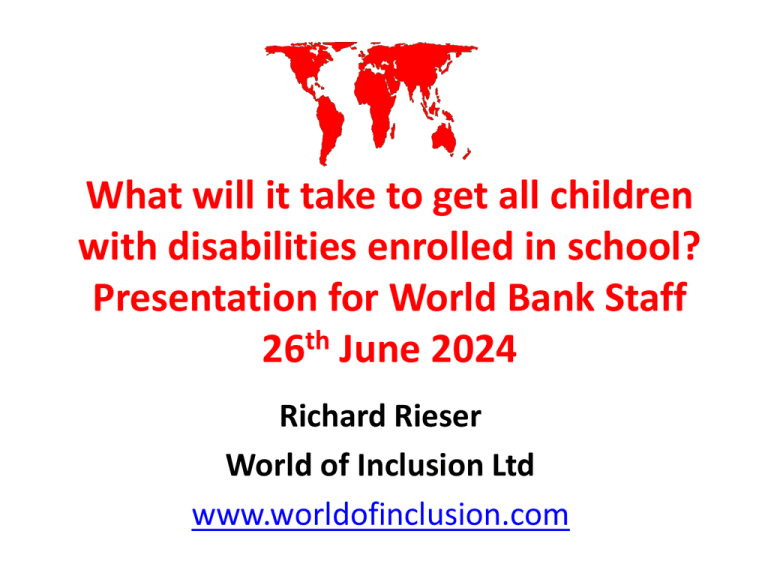
What will it take to get all children
with disabilities enrolled in school?
Presentation for World Bank Staff
26th June 2024
Richard Rieser
World of Inclusion Ltd
www.worldofinclusion.com
Global Campaign for Education Focus in 2014
on getting children with disabilities into school
• Of 57 million still not in school may be as many as 33%- 40%*
are Children with Disabilities CWD
• In Malawi and Tanzania, a CWD is twice as likely to have never
attended school as a child without a disability. In Burkina Faso,
having a disability increases the risk of children being out of
school by two and a half times.
• In Bolivia it is estimated that 95% of the population aged 6 to
11 years are in school, while only 38% of children with
disabilities are .
• In Ethiopia, according to the Ministry of Education, fewer than
3% of children with disabilities have access to primary
education, and access to schooling decreases rapidly as
children move up the education ladder.
• In Nepal, 85% of all children out of school are disabled.
*LCD evidence to UK Joint Human Rights Committee and Global Campaign for
Education 2014
World Report on Disability 2011
• We do not have accurate and disaggregated
data.
• According to the World Report on
Disability approximately one billion people in
the world are living with a disability(15%), with
at least 1 in 10 being children and 80% living in
developing countries.
• It is estimated that 93 million of these
are children – or 1 in 20 of those aged up to 14
years of age – living with a moderate or severe
disability.
Proportion of 6-11 year olds in school with and without disabilities
Source Filmer,D- Disability, poverty and schooling in developing countries 14 household
surveys The World Bank Economic Review 2008
For CWD who make it to school•
•
•
•
The quality of education is poor, often segregated
It is not adapted to their needs
The materials are not accessible
The teachers have negative attitudes and do not feel prepared to
teach them
• Parents don’t see the point in continuing their education
• Peers can harass if not challenged
• Overall, even in countries with high primary school enrolment
rates, disabled children are more likely to drop out of school than
any other vulnerable group, including girls, those living in rural
areas or low-income children.[GPE-November 4th 2013 blog]
• World Bank(2004) India 5 times more likely than other groups
UNITED NATIONS CONVENTION ON THE RIGHTS OF
PEOPLE WITH DISABILITIES DEC. 2006:A NEW
PARADIGM CENTERED ON THE PERSON WITH
DISABILITY
From Medical Model of
Disability Problem in
the Person.
Cure, Fix or Separate
To
To Social Model of Disability
based on Human Rights
approach- Problem with Society
that needs to be changed.
Attitudes
Organisation
Environment
158 signatories to
the Convention
147 ratifications
of the Convention
Optional Protocol
92 signatories
82 ratifications
Shifting the Focus at UN
• “Recognizing that disability is an evolving concept and
that disability results from the interaction of persons with
impairments and attitudinal and environmental barriers
that hinders their full and effective participation in society
on an equal basis with others.”
• Paradigm Shift -Persons with disabilities are not viewed as
"objects" of charity, medical treatment and social
protection; rather as "subjects" with rights, who are
capable of claiming those rights and making decisions for
their lives based on their free and informed consent as
well as being active members of society.
• http://www.un.org/disabilities/
Individual/Medical/Charity Model Problem in the Person
Can’t get to
school, or get
in, or around
the building
Is bewitched, evil
or a punishment
Can’t keep up with
the class
Does not
understand
Is contagious
Wastes scarce
resources
Will be bullied by
the other children
Is not like the
other children
Needs specialist
teaching/help
Needs to be kept
away from the other
children
Social /Human Rights Model
Problem in Society-Address barriers of attitude, environment and organisation
Address negative
attitudes and superstition
Develop expertise in
alternative communication
Rigid methods, curriculum
and assessment
Reduce costs to pupil and
family
Inaccessible buildings and
environments
Make and provide aids and
equipment
Improve quality of teaching
to prevent drop-out
Inform and Involve Parents
Provide person centred and
functional assessment and plan
Provide teachers and schools with
training and support
Organisation of education for children with disabilities
1.Exclusion
2.Segregation-separation
3.Regular school with Unit
?
Not go to
school
Special school
for “special”
children
4. Integrationconditional acceptance
Therapy
Rehabilitation
Child has to cope with school as it
Regular or
mainstream school
for the rest
5.Resource bases
in mainstream
Additional room and
teacher. Child most
time with peers
Same building separate
teaching
6.Inclusion
All welcome, school adapts
to provide support and
make adjustments
UNCRPD Article 24 Education
• Requires all signatories to ensure all disabled children
and young people can fully participate in the state
education system and that this should be an ‘inclusive
education system at all levels’
• The development by persons with disabilities of their
personality, talents and creativity, as well as their
mental and physical abilities, to their fullest potential.
• This right is to be delivered within an inclusive primary
and secondary education system, from which disabled
people should not be excluded.
• Reasonable accommodations should be provided for
individual requirements and support provided in
individualised programmes to facilitate their effective
social and academic education.
UNCRPD Article 24 Education -2
• Instruction in Braille , Sign language AAC
• Employment of disabled teachers
• Train professionals and staff who work at all
levels of education. Such training shall
incorporate disability awareness and the use of
appropriate augmentative and alternative
modes, means and formats of communication,
educational techniques and materials to support
persons with disabilities
• Article 8 b-Awareness Raising ‘Fostering at all
levels of the education system, including in all
children from an early age, an attitude of
respect for the rights of persons with
disabilities’
Putting the Paradigm Shift into Practice in Education
•
Special needs or special education purposely not mentioned in UNCRPD
•
Special education in developed countries, but also in developing countries, can
help create and reiterate negative stereotypes towards students and persons
with disabilities.
Additionally, the removal of children with disabilities from the mainstream
education denies students without disabilities access to the experience of
disability, which in turn perpetuates ignorance and stigma.
•
•
The social model of disability reflected in the CRPD, recognizing the combination
of a person’s impairment situated in a discriminating society, requires changing
the social system, which includes the education system.
•
Special education today reproduces the discriminatory social system by
reinforcing the assumption that individuals with specific characteristics do not fit
in society and thus places them in separate situations.- International Disability
Alliance 2011
• All teachers need Disability Equality Training delivered by trainers with
disabilities to challenge negative attitudes and promote social model
thinking.
Need a Twin Track approach in
Schools and Classrooms
Track One
Track Two
Inclusive Teaching and Learning
Impairment Specific Adjustments
Ethos Equality & Valuing Difference
Barriers Identified-Solutions found
Child Centred
Peer Collaborative Learning
Differentiation
Flexible Curriculum& Assessment
Stimulating learning materials
Ensure Anti-Bias Curriculum
Reflective and collaborative teachers
Quality education requiring rigour and
effort by each child to achieve
potential
Blind and Visually Impaired
Deaf & Hearing Impaired
Deaf Blind
Speech & Communication
Physical Impairment
Specific Learning Difficulty
Mental Health and Behaviour
General Cognitive Impairment
Medical Needs
Screening, identification and key
adjustments for main impairments
India,Dhravi ,Mumbai, India
17 Angawadis Pre- School. NGO
ADAPT.
Workers come from slum and
trained. Materials made from what
is available e.g.Plastic Bottles, old
socks, bottle tops and match boxes.
Now SSA across the whole country
2010 All disabled children a right to
education .
Zanzibar
• 20 pilot schools then doubled-4,300 CWD
in 86 schools/420
• 144 teachers trained Braille /Sign
Language
• 2,225 teachers trained in Inclusive
Education
• Provide aids and equipment
• Worked bottom up utilising existing
community networks-ZAPDD
• Pilot schools parents and facilitator train
teachers
• Set up local training centres
• Dept or Inclusive Education in Ministry of
Ed.
• Dependent on funding NORAD/NFU
Key to have a local facilitator using
Community Based Rehabilitation
methods. Utilise existing social
capital-social networks
Brazil
Mata Escura, Brazil
2001 everyone a right to education
By 2011 Brazil had established 30,000
resource bases in schools to support
the learning of disabled children.
They have Braille facilities
Sign Language and Augmented and
Facilitated Communication
Learning materials
ASNIC, Associación Nicaragüense para la Integración
Communitaria Nicaragua
ASNIC, Managua has been working with a UK development agency,
CODA, Community Development and Action International (with
funding from the UK Big Lottery), to address the massive
educational disadvantage among disabled children in Nicaragua.
ASNIC is working on several fronts, for example to draw attention to
their situation through the mass media, link Disabled People’s
Organisations to the Education Ministry and empower teachers to
enhance their skills in meeting this challenge.
The main focus of its approach is in raising awareness of the rights of
disabled people in local communities, strengthening their capacity
for informed advocacy and showing how their inclusion benefits
everyone.
They have a local advocacy strategy with priorities. Such as a joint
campaign secure the admission of disabled children into the public
schools.
Since its creation in 1996, ASNIC has successfully participated in
national and international lobbying that has resulted in the
inclusion of rights of PWD in important national, regional and
international legal and policy instruments, like the Declaration of
Managua and the Declaration of the City of Quebec. ASNIC has
managed and implemented important projects for the inclusion of
PWDs and their families, like Inclusive Education, and creating
strategies for increase a involvement in theirs communities.
Example 3 Instituto Patria, Mexico City
Instituto Patria is a physically accessible, private school in the Jesuit tradition, situated in pleasant suburbs of Mexico
City. It serves around 200 children in pre-school, primary and now the early years of secondary education. It attracts
sufficient income from fees to offer small classes (varying from 6 to 20 pupils) with flexible teaching.
Committed to including up to 15% of pupils with special needs, mostly disabled children.
The school is bi-lingual (there is teaching in Spanish and English) but its third main theme is inclusion, so nearly a third
of its teaching staff also have skills in psychology, speech therapy and other disciplines and increasingly all teachers are
acquiring some of these skills in their own classroom practice.
Three coordinators of teaching programmes (respectively in Spanish, English and inclusion) work with the Principal and
other teachers to shape the curriculum for each pupil and plan its delivery. The inclusion team is available to partner
the classroom teachers in their classes when these include children with additional needs and ensure they (and others)
get individual support when required.
The school invests in fortnightly in- house training both to help teachers explore their philosophy and inclusion.
Parents are encouraged to understand the diversity of the school before registering their children and every child has
the opportunity to ‘try out’ the school before accepting entry.
http://www.centreforwelfarereform.org/uploads/attachment/291/advancing-inclusive-education-for-an-inclusivesociety.pdf
Colombia:Municipality of Cali,
education system reform
Cali is the third largest city in Colombia and is characterised both by
many kinds of population diversity and by massive economic
inequalities. The Mayor in 2009 was elected on a platform of
tackling these inequalities and promoting Cali as an ‘inclusive
city’. Established three years ago a municipal office focused on
inclusion which in turn has undertaken a wide-ranging study to
produce a socio-spatial map of the city measuring different
dimensions of exclusion.
A key focus of its work has been inclusive education. Equipped with
this map targeted, through the Education Department, both
the communities and the schools with the largest numbers of
vulnerable children in a rolling programme of interventions
which will be spread more widely as resources allow.
The strategy combines consultation with these communities about
the challenges with a package of policies, incentives and
supports, including: Free schooling and subsidised uniforms
and transport, books and tools for poor students. A significant
programme of post-graduate training for selected school
Principals and teachers, prioritising those involved in ‘school
improvements committees’. A central team supporting schools
in preparing and implementing their own transformation plans.
Poverty
1999
Schools as Centres of Care and Support
(SCCS) KwaZulu Natal
The SCCS has been used and tested, both
within and beyond South Africa, as a
model of mainstream care and support in
education. The following key principles
have contributed to the model’s success and
replicability:
•The school supports communities to
respond to poverty, HIV & AIDS, conflict and
gender-related issues.
•Meaningful participation by children, youth,
the school and its community.
•Culturally and contextually appropriate
approaches.
•Existing structures and initiatives are built on.
After successful pilot in Uglo
district. All KZN and 5 other SADC
countries now operate.
MIET
• A multi-sectoral partnership approach.
Social Work, Health and Education.
Integrated into government plans and
budgets.
Friends at College Alberta,
Canada
Graduation
Inclusive Education -UNESCO
Inclusive Education -UNESCO sees inclusive
education as a process of addressing and
responding to diversity of needs of all learners
through increasing participation in learning,
cultures and communities, and reducing
exclusion within and from education. It involves
changes and modifications in content,
approaches, structures and strategies, with a
common vision which covers all children of
appropriate age range and a conviction that it is
the responsibility of the regular system to
educate all children. 2006
Principles of Inclusive Education
•Inclusion is a process. That is to say, inclusion has to be seen as a
never-ending search to find better ways of responding to diversity.
• Inclusion is concerned with the identification and removal of
barriers.
• Inclusion is about the presence, participation and achievement of
all students.
• Inclusion involves a particular emphasis on those groups of learners
who may be at risk of marginalisation, exclusion or
underachievement.
Mel Ainscow UNESCO ICE 48 Geneva Nov 2008
So Inclusion is not ‘one size fits all’ but a process of community building and bottom up
school empowerment.
The Constellation of Services
Transport to
school
Community
Based
Rehabilitation
Social Worker Aids/Orphans
Advisor
School Based Community
Support Group Facilitator
Parents
Groups
CHILD
Friends
Brothers
and Sisters
HI/VI
Specialist
Itinerant Teacher
TEACHER
DPOs
Disabled
Peoples Orgs
Therapists
Behaviour
Support Team
NGOs/Donors
Finance Support
Head teacher
Multi-disciplinary
Assessment
Doctor,Therapist,
Nurse,Psychologist
County/ Municipality
Inclusion
Officers
Volunteers
Ministry
of Education
Balance Sheet on Progress to Inclusive education for CWD
Positives
•
•
•
•
•
•
•
•
UNCRPD-Presence of CWD has
been encouraged in many
countries[147 ratified]
Many NGO initiated projects. Only
India, Brazil and South Africa
attempts to scale up.
Know what to do to make IE workchild centred, flexible
Know to train all teachers in Twin
Track approach
Know all schools need to be
accessible-DfID and GPE
CBR has convinced parents their
CWD has a right to education
Bottom up change works
Wider awareness of finite
resources and delicately balanced
eco-systems=need to Collaborate
Negatives
•
•
•
•
•
•
•
•
Amount of money has fallen
reduction in overall amount and
share going to basic
education.[since 2009 drop 16%]
Shortage of trained
teachers[1.6million needed]
Much integration, little Inclusion
Drop out and non-transition to
Secondary far too high
Stereotyping and discrimination
still rife
Governments not developing
comprehensive plans and
approaches to disability equality
Top down change fails
GERM-pushing for standardisation,
testing and privatisation and
narrow curriculum and assessment
= Competition
How can finance be mobilised to bring inclusion initiatives to scale?
•Donors and funders need to get resources down to local level
where local people have democratic control on funding.
•Utilise existing social networks and social capital and fund
community groups
•Ear-mark funding linked to targets of recruitment of pupils with
disabilities
•Retention bonuses for those social groups who drop out and
don’t complete basic education-linked to economic benefits of
continuing in education
•Support for training Community Based Rehabilitation workers at
local level trained in human rights/social model approach
•Investment in capacity building ( Disability Equality Training) of
local Disabled People’s Organisations and Parents Groups that
advocate Inclusive Education
•Investment in developing and training local advocates of
Inclusive Education
How can finance be mobilised to bring inclusion initiatives to scale?-2
•Shifting control of budgets to Parents and Governors
•Funding all headteachers to be trained in Inclusive Education
(both tracks) to lead whole-staff training of their school to
complete diploma in Inclusive Education
•Fund mandatory training for all pre-service teachers on twin
tracks of inclusion
•Fund Do It Yourself kits to make all schools accessible, have clean
running water, sex separated accessible toilets
•Solar power so all schools can get on internet using non-copyright
software
•Develop Inclusion resource centres and specialist peripatetic
teachers in each district
•Invest in pay and conditions of teachers and their training levels.
•Long term and consistent funding and monitoring.
Quality Inclusive Education for CWD Needs to be a Post Millennium Development Goal



